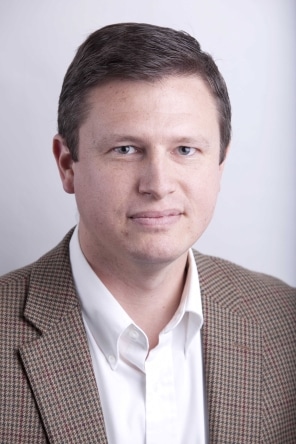Jun 30 2016
Two Indiana University chemists have received $525,000 from the National Science Foundation to advance research with applications to the emerging field of carbon recycling.
 Steven L. Tait. Photo by Indiana University
Steven L. Tait. Photo by Indiana University
IU scientists Steven L. Tait and Kenneth Caulton will combine their expertise in two distinct fields of chemistry -- surface chemistry and metal-organic chemistry -- to create new catalysts that guide molecular transformations.
An example of this type of transformation is converting environmentally harmful carbon dioxide molecules into carbon-neutral plastics, building materials and fuel. Carbon dioxide, or CO2, is the product of combustion of gasoline or coal.
"The conversion of molecules into new forms, including 'recycling' carbon, is a broad challenge in chemistry," said Tait, associate professor in the IU Bloomington College of Arts and Sciences' Department of Chemistry, who is principal investigator on the project. "Our work will advance the field by applying methods pioneered at IU toward the development of reactions not yet attainable outside highly controlled laboratory environments."
The co-investigator on the project is Caulton, an IU Distinguished Professor of Chemistry and world-renewed expert in metal-organic chemistry, which employs organic materials to isolate and organize single metal atoms into powerful, complex structures, roughly analogous to enzymes, the molecules of life.
Tait's and Caulton's labs began to collaborate nearly two years ago. Support from the NSF was based in part upon the strength of these early experiments, in which the two teams successfully engineered a new type of surface from highly organized metal atoms that reacted chemically with carbon dioxide gas.
The ability to coax a surface reaction of this kind from carbon dioxide was a breakthrough since the bond between a single carbon atom and two oxygen atoms is extremely strong and difficult to disrupt or convert into more valuable products.
By building upon these preliminary results, the IU scientists will design more sophisticated reactions. An ultimate goal would be the merger of two CO2 molecules into C2O4, or “oxalate,” a highly versatile but difficult-to-create molecule with useful industrial applications.
"There are economically feasible methods for transforming oxalate into other chemicals, including plastics, building materials or fuel," Tait said. "But first you've got to develop a reaction that is cost effective and scales up in a practical way."
Significantly, fuels created from recycled carbon dioxide emissions are carbon neutral since burning them does not raise the overall amount of carbon in the atmosphere.
The processes currently used in manufacturing aren’t fine-tuned enough to convert carbon dioxide into oxalate on a large scale. By contrast, the IU team's manipulation of metals at the level of individual atoms provides a far greater level of control over both the catalyst and its product.
The result would be a sort of "catalytic convertor 2.0" that transforms non-poisonous -- but still environmentally destructive – carbon dioxide into oxalate. (Current catalytic convertor technology in cars uses hundreds platinum, palladium and rhodium atoms as a surface catalyst to transform poisonous carbon monoxide into carbon dioxide, which isn’t deadly but still harms the environment.)
"This project is really about advancing a new, highly delicate form of chemistry," Caulton said. "We're separating out metal atoms so they’re laid out identically across a surface. At this level of granularity, things start to act differently. We’re able to reach levels of precision and complexity in our reactions that weren’t previously attainable."
Beyond carbon recycling, the methods advanced under the grant could inform the creation of other useful molecules and could make a big impact in states such as Indiana, where manufacturing and fossil fuels remain important to both economic and energy production.
"If you could create technology that pulls emissions from coal power or cars and reuse it -- to recycle all that CO2 rather than letting it escape into the atmosphere -- it could play a big role in the economy," Tait said. "We're working hard to push the limits of what can be done."
The members of Tait's and Caulton's labs who first helped established the collaboration between their teams in 2014 were Brian Cook, a Ph.D. student in Caulton's lab, and Daniel Skomski, a senior scientist at Merck who contributed to the research while a Ph.D. student in Tait's lab.
The NSF support will continue through 2019.
Source: https://www.indiana.edu/